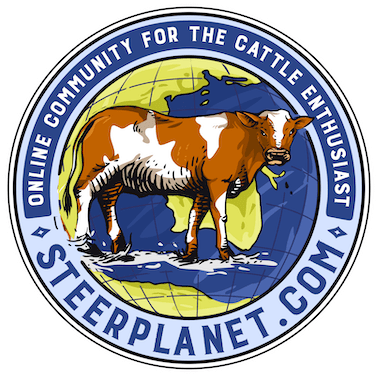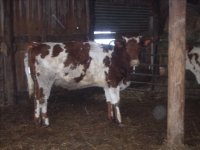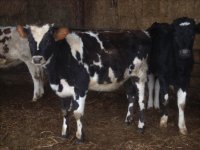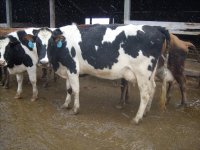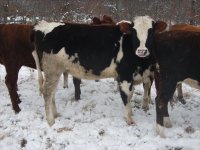The Holstein breed has what's call a list of Black/ Red carriers. I have seen this mostly in our 'Red' Holstein looking cattle- that are mainly from crossed high percentage holsteins and sired by AI Holstein bulls.
Here's a breif explanation of it, taken from a quick google search
http://www.absoluteastronomy.com/topics/Holstein_(cattle):
An American Breeders Service (ABS) ad in the Canadian Holstein Journal in 1974 on Hanover-Hill Triple Threat mentioned one of several colour variants that were not true red. Its existence was undoubtedly common knowledge among breeders in both countries, but up until that time it had not been mentioned in print. Calves were born red and white and registered as such, but over the first 6 months of age turned black or mostly black with some reddish hairs down the backline, around the muzzle and at the poll. The hair coat colour change became known as Black/Red(B/R) and sometimes as Telstar/Red, since the condition appeared in calves sired by Roybrook Telstar. Telstar was the sire of Triple Threat, but nothing about this had hitherto been in print about Telstar who was by then over 10 years old.
Black/Reds were often discriminated against when sold and were barred from Red and White-sponsored shows. In 1984 Holstein Canada considered recoding B/R bulls that had always been coded simply as red carriers, a designation that was not acceptable to all buyers. The breed agreed to change after checking with other breed associations and with the AI Industry. In 1987, Holstein Canada and the Canadian A I Industry modified their coding procedures to distinguish between Black/Red and true red colour patterns for bulls. Holstein Canada dropped the suffix Red as a part of the name in 1990, but continue to carry it as part of the birth date and other codes field.
The easiest pathway to trace when looking at the migration of the red trait in Canada is to work back through the ancestry of ABC's sire, Montvic Rag Apple Sovereign. Sovereign was sired by Emperor of Mount Victoria-RC.
In Canada the sire Agro-Acres Marquis Ned-RC was born in 1964 and was extremely popular in Canada, siring a number of well-known Red and White females that were imported by US breeders. Among them were Blue-Haven Rose Ned-Red. A popular red-carrier sire was Roybrook Telstar.
Hanover-Hill Triple Threat had a huge influence on Holstein breeding in both the United States and Canada during the 1970s and 80s. He was considered a good mate for the daughters of Elevation, Bootmaker, and other highly rated sires from both countries, despite the fact that he carried the Black/Red trait. Glenafton Enhancer was dominant in the 1980s as a sire of sons for AI units. He was a son of Roybrook Starlite.
With this said: I have noticed mostly in the young calves-- and in the old cows who'll change depending on the season of the year...
